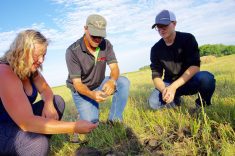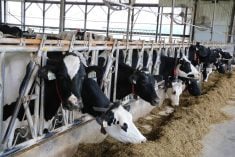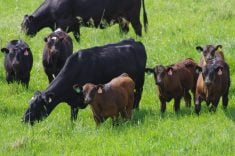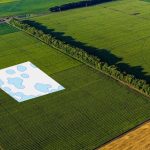Farmers use a variety of methods to determine when alfalfa is ready for the first cut of the year, but this season a lot of those methods went straight out the window.
“So how many of you are just cutting when it’s dry enough to get on the field?” Dan Undersander, an extension and forage agronomist at the University of Wisconsin, recently asked a group of producers gathered near Steinbach.
In response, most hands in the room shot up.
Read Also

Ag Days Gives Back 2026 focuses on fire response
Manitoba Ag Days charitable program, Ag Days Gives Back, returns for 2026 with a new wave of rural community support in Manitoba and southeast Saskatchewan
A cool, wet spring in much of the province has slowed growth and made it difficult for producers to get on the land to make hay or silage.
“For the fellows who got their first cut off around the 9th and 10th of June — there was quite a few in the southeast because there was a good window of opportunity there if you were taking it off for silage — those fellows are probably looking at starting to cut again next week, around the 17th to the 20th of July,” said John McGregor, an extension specialist with the Manitoba Forage and Grassland Association.
- From the Grainews website: Excess moisture costs Man. producers pasture, hayland
“But there are areas of the province where fellows are just now doing first cut,” he added.
Undersander said height is a good indicator when it is time to make the first cut.
“Cut at 28 inches or when it gets to the bud stage, whichever comes first,” he told producers looking for dairy-quality hay. For beef cattle, he said first cutting should come once the stand reached 30 or 31 inches.
But while height can put you in the ballpark, McGregor advocates for greater attention to growth stage.
“In Manitoba, what we’ve found is that 26 to 30 inches is not a bad range to be at, but there are a number of years where we either have cool growing conditions, where the alfalfa doesn’t grow very quickly, or we get environmental conditions that cause it to be ready at 16 or 17 inches of height,” he said. “You want to watch the height, but you also want to watch the stage of the crop. If it’s short and it’s starting to go into the early-bud stage, you might want to start thinking about doing some cutting.”
This year, weather will also be a big factor when it comes to how and when producers make their hay and silage. If producers see a dry period of three or four days on the horizon, McGregor said they should be making hay, even if it means cutting on the early side.
“You can always work with high-quality feed, it’s more difficult with low-quality feed,” he said.
Producers can also change how they put up their hay to save time.
“They can do things like laying out a wide swath, and letting it dry down very quickly… some farmers are putting it up as round bale silage and you know they can cut it one day and put it up the next day,” McGregor said. “So for some, it’s changing the way that they cut or swath their hay that could conceivably knock a day off the drying process — so we could go to needing only 2-1/2 days or three days to put up dry hay instead of the typical four to five days.”
The recent stretch of dry weather has seen many farmers head out onto the fields to make hay, the extension adviser said, adding that producers have had plenty of experience in Manitoba when it comes to balancing production schedules and the weather.
But defining normal weather is no longer possible, he said, adding that can make it more difficult for producers to plan.
Still, McGregor said he believes farmers will get a strong second cutting of alfalfa later in the year, which will help balance out lower-quality first cuttings.
“I think that we’re going to see some fairly large volumes of hay, and I don’t mean a bumper crop or anything like that. But right now the crop that’s out there has had the opportunity to grow a lot, so there’s going to be a lot of volume there, but it’s going to probably be lower quality than they’re used to,” he said.















